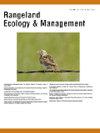Well-Connected Core Areas Retain Ecological Integrity of Sagebrush Ecosystems Amidst Overall Declines From 2001–2021
IF 2.4
3区 环境科学与生态学
Q2 ECOLOGY
引用次数: 0
Abstract
Conservation of species’ mobility and ecological integrity is necessary for the productivity of the sagebrush biome in the western United States. Building on the recently developed Sagebrush Conservation Design (SCD) that mapped sagebrush ecological integrity (SEI)—defined as the higher cover of sagebrush and perennial grass and reduced threats due to invasive annual grass, tree encroachment, and human disturbance—we modeled the structural connectivity of sagebrush ecosystems to better incorporate the role of landscape-level processes into assessments of integrity. Because integrity can vary spatially, as well as temporally, we quantified both interannual variability and trends in variability in SEI from 2001–2021. We used the resultant map to identify areas with high structural landscape connectivity (i.e., “well-connected cores”), then determined the coincident core sagebrush areas (CSAs) that represent functioning sagebrush ecosystem with few landscape threats, and growth opportunity areas (GOAs) that represent functioning systems impacted by one or more threats as originally defined and mapped in the SCD. We found that CSAs were located in areas with higher landscape connectivity, and the biome-wide average of SEI declined by 30% from 2001 to 2021, although the structural connectivity biome-wide declined one-third less (by 20%). CSAs located in areas with high connectivity had 25% higher SEI values on average than those with low connectivity, and the trend in declining SEI values was slower. Our datasets of landscape connectivity can be combined with other SCD products to provide a broader ecosystem context—both spatially and temporally. Our results can be used to inform, refine, focus, and prioritize conservation and management efforts to those CSAs and GOAs we identified as particularly well connected and which may be more resilient to recently altered dynamics and declines—those that will serve to anchor efforts to conserve the sagebrush biome in light of changing land use and climate.
连接良好的核心区域在 2001-2021 年间全面衰退的情况下保持了沙棘生态系统的生态完整性
保护物种的流动性和生态完整性对于提高美国西部鼠尾草生物群落的生产力十分必要。最近开发的 "鼠尾草保护设计"(Sagebrush Conservation Design,SCD)绘制了鼠尾草生态完整性(SEI)图,将其定义为较高的鼠尾草和多年生禾本科植物覆盖率,以及因入侵的一年生禾本科植物、树木侵占和人为干扰而减少的威胁。由于完整性在空间和时间上都会发生变化,因此我们对 2001-2021 年期间 SEI 的年际变化和变化趋势进行了量化。我们利用绘制的地图确定了具有高度结构景观连通性的区域(即 "连通性良好的核心"),然后确定了代表功能正常且景观威胁较少的鼠尾草生态系统的重合核心鼠尾草区(CSA),以及代表功能正常且受到 SCD 最初定义和绘制的一种或多种威胁影响的增长机会区(GOAs)。我们发现,CSA 位于景观连通性较高的区域,整个生物群落的 SEI 平均值从 2001 年到 2021 年下降了 30%,尽管整个生物群落的结构连通性下降了三分之一(20%)。位于高连通性区域的 CSA 的 SEI 值平均比低连通性区域的 CSA 高 25%,而且 SEI 值的下降趋势较慢。我们的景观连通性数据集可与其他 SCD 产品相结合,以提供更广泛的生态系统背景(包括空间和时间方面)。我们的研究结果可用于为那些我们认为连接性特别好、对最近发生的动态变化和衰退具有更强复原力的生态系统服务区和全球海洋观测区提供信息、进行改进、突出重点并优先考虑保护和管理工作--这些生态系统服务区和全球海洋观测区将在不断变化的土地利用和气候条件下成为保护鼠尾草生物群落的支柱。
本文章由计算机程序翻译,如有差异,请以英文原文为准。
求助全文
约1分钟内获得全文
求助全文
来源期刊

Rangeland Ecology & Management
农林科学-环境科学
CiteScore
4.60
自引率
13.00%
发文量
87
审稿时长
12-24 weeks
期刊介绍:
Rangeland Ecology & Management publishes all topics-including ecology, management, socioeconomic and policy-pertaining to global rangelands. The journal''s mission is to inform academics, ecosystem managers and policy makers of science-based information to promote sound rangeland stewardship. Author submissions are published in five manuscript categories: original research papers, high-profile forum topics, concept syntheses, as well as research and technical notes.
Rangelands represent approximately 50% of the Earth''s land area and provision multiple ecosystem services for large human populations. This expansive and diverse land area functions as coupled human-ecological systems. Knowledge of both social and biophysical system components and their interactions represent the foundation for informed rangeland stewardship. Rangeland Ecology & Management uniquely integrates information from multiple system components to address current and pending challenges confronting global rangelands.
 求助内容:
求助内容: 应助结果提醒方式:
应助结果提醒方式:


